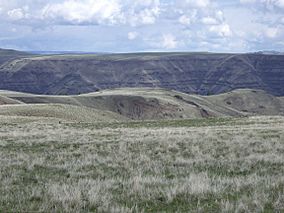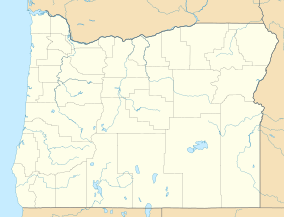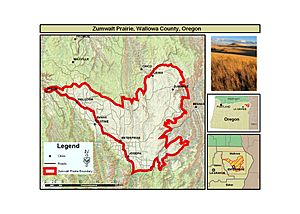Zumwalt Prairie facts for kids
Quick facts for kids Zumwalt Prairie |
|
|---|---|
|
IUCN Category V (Protected Landscape/Seascape)
|
|

Zumwalt Prairie landscape
|
|
| Location | Wallowa County, Oregon, U.S.A. |
| Nearest city | Enterprise, Oregon |
| Area | 330,000 acres (130,000 ha) |
The Zumwalt Prairie is a huge area of grassland in northeast Oregon, United States. It's located in Wallowa County. This special place covers about 330,000 acres (which is about 133,546 hectares).
A lot of the land here is used for farming. But some parts are protected as the Zumwalt Prairie Preserve. This preserve is looked after by an organization called The Nature Conservancy. A special part of the preserve is even called a National Natural Landmark. This means it's a really important natural area. The prairie sits high up, right next to Hells Canyon, which is a deep river gorge on the border between Oregon and Idaho.
Contents
What is the Zumwalt Prairie Like?
The Zumwalt Prairie is on top of a basalt plateau. A plateau is like a flat-topped mountain. The land here is between 3,500 and 5,500 feet (about 1,067 to 1,676 meters) high.
The prairie is mostly covered by different kinds of native bunchgrasses. These include Idaho Fescue, Bluebunch wheatgrass, and Sandberg's Bluegrass. You can also find many beautiful wildflowers growing here.
The Zumwalt Prairie is a rare example of a large grassland that used to cover much of western North America. Most other prairies have been changed by farming or building. But because the Zumwalt Prairie is so high up, has a tough climate, and poor soil, it was hard to farm. This helped keep it mostly natural. Because of this, many important homes for plants and animals are still here.
Amazing Animals of Zumwalt Prairie
The Zumwalt Prairie is home to many different animals. It's especially known for its birds of prey, also called raptors. These are birds that hunt other animals.
Birds of Prey
You can often see many kinds of hawks flying high above the prairie. Some of these include the ferruginous hawk, swainson's hawk, rough-legged hawk, and red-tailed hawk. Golden eagles are also a common sight, soaring gracefully in the sky.
Grassland Songbirds
The prairie is also a very important place for songbirds that live in grasslands. These include the Savannah sparrow, western meadowlark, vesper sparrow, horned lark, and grasshopper sparrow. Many grassland birds are in danger, and they need large, open areas like the Zumwalt Prairie to survive and have their babies.
There's also a special effort to bring back the Columbian sharp-tailed grouse. This bird used to live on the Zumwalt Prairie but disappeared by 1947. Now, people are working to reintroduce them.
Other Wildlife
Besides birds, many other animals live here. You might see Belding's ground squirrels and northern pocket gophers. Larger animals include Rocky Mountain elk, mule deer, and white-tailed deer.
Predators like black bears, cougars, bobcats, badgers, and coyotes also live on the prairie. After being gone for about 50 years, gray wolves have started to return to this part of Oregon and have been seen on the Zumwalt Prairie.
Tiny Helpers: Insects
The Zumwalt Prairie also has many different kinds of insects. There are over 100 different types of bees! These bees are super important because they help pollinate the plants. This means they help the plants make seeds and grow, which keeps the grassland healthy.
Weather at Zumwalt Prairie
The climate at Zumwalt Prairie is called continental and semi-arid. This means it has hot summers and cold winters, and it doesn't get a lot of rain.
The prairie usually gets about 15 to 17 inches (about 38 to 43 centimeters) of rain or snow each year. Most of this precipitation falls during the winter months. July and August are the driest months. In summer, the average high temperature is about 84°F (29°C). Winters are cold, with the average low temperature around 16°F (-9°C).
History of the Zumwalt Prairie
The first people to live on the Zumwalt Prairie were the Chief Joseph band of the Nez Perce. These Native American people used the area for hunting and gathering food in the spring and fall.
People from Europe and America started settling in the area in the 1850s. The Nez Perce were forced to leave the area in the late 1870s. This happened after President Ulysses S. Grant allowed white settlers to move into Wallowa County.
Today, most of the prairie is made up of privately owned ranches. These ranches use the land for summer grazing, where cattle eat the grass. In 2013, a part of the prairie was officially named a National Natural Landmark.
Protecting the Zumwalt Prairie
The Nature Conservancy is an organization that works to protect nature. They own and manage a nature preserve on the Zumwalt Prairie that covers about 36,000 acres (about 14,569 hectares).
They are doing many things to understand and protect the amazing plants and animals here. This includes studying the different living things, watching how the environment changes, and doing scientific research. About 4,400 acres (about 1,780 hectares) of The Nature Conservancy's land is part of the National Natural Landmark.



